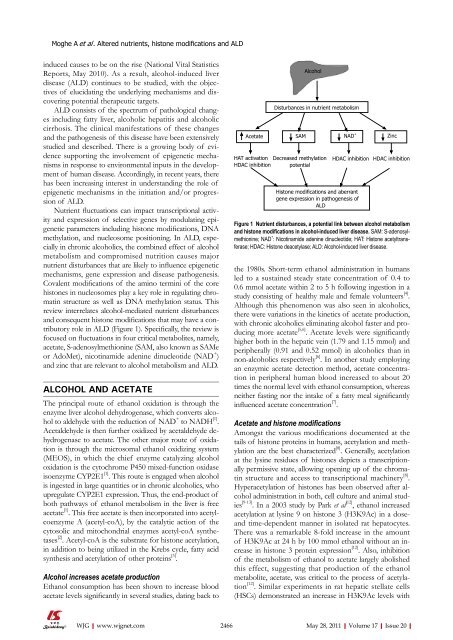20 - World Journal of Gastroenterology
20 - World Journal of Gastroenterology
20 - World Journal of Gastroenterology
You also want an ePaper? Increase the reach of your titles
YUMPU automatically turns print PDFs into web optimized ePapers that Google loves.
Moghe A et al . Altered nutrients, histone modifications and ALD<br />
induced causes to be on the rise (National Vital Statistics<br />
Reports, May <strong>20</strong>10). As a result, alcohol-induced liver<br />
disease (ALD) continues to be studied, with the objectives<br />
<strong>of</strong> elucidating the underlying mechanisms and discovering<br />
potential therapeutic targets.<br />
ALD consists <strong>of</strong> the spectrum <strong>of</strong> pathological changes<br />
including fatty liver, alcoholic hepatitis and alcoholic<br />
cirrhosis. The clinical manifestations <strong>of</strong> these changes<br />
and the pathogenesis <strong>of</strong> this disease have been extensively<br />
studied and described. There is a growing body <strong>of</strong> evidence<br />
supporting the involvement <strong>of</strong> epigenetic mechanisms<br />
in response to environmental inputs in the development<br />
<strong>of</strong> human disease. Accordingly, in recent years, there<br />
has been increasing interest in understanding the role <strong>of</strong><br />
epigenetic mechanisms in the initiation and/or progression<br />
<strong>of</strong> ALD.<br />
Nutrient fluctuations can impact transcriptional activity<br />
and expression <strong>of</strong> selective genes by modulating epigenetic<br />
parameters including histone modifications, DNA<br />
methylation, and nucleosome positioning. In ALD, especially<br />
in chronic alcoholics, the combined effect <strong>of</strong> alcohol<br />
metabolism and compromised nutrition causes major<br />
nutrient disturbances that are likely to influence epigenetic<br />
mechanisms, gene expression and disease pathogenesis.<br />
Covalent modifications <strong>of</strong> the amino termini <strong>of</strong> the core<br />
histones in nucleosomes play a key role in regulating chromatin<br />
structure as well as DNA methylation status. This<br />
review interrelates alcohol-mediated nutrient disturbances<br />
and consequent histone modifications that may have a contributory<br />
role in ALD (Figure 1). Specifically, the review is<br />
focused on fluctuations in four critical metabolites, namely,<br />
acetate, S-adenosylmethionine (SAM, also known as SAMe<br />
or AdoMet), nicotinamide adenine dinucleotide (NAD + )<br />
and zinc that are relevant to alcohol metabolism and ALD.<br />
ALCOHOL AND ACETATE<br />
The principal route <strong>of</strong> ethanol oxidation is through the<br />
enzyme liver alcohol dehydrogenase, which converts alcohol<br />
to aldehyde with the reduction <strong>of</strong> NAD + to NADH [1] .<br />
Acetaldehyde is then further oxidized by acetaldehyde dehydrogenase<br />
to acetate. The other major route <strong>of</strong> oxidation<br />
is through the microsomal ethanol oxidizing system<br />
(MEOS), in which the chief enzyme catalyzing alcohol<br />
oxidation is the cytochrome P450 mixed-function oxidase<br />
isoenzyme CYP2E1 [1] . This route is engaged when alcohol<br />
is ingested in large quantities or in chronic alcoholics, who<br />
upregulate CYP2E1 expression. Thus, the end-product <strong>of</strong><br />
both pathways <strong>of</strong> ethanol metabolism in the liver is free<br />
acetate [1] . This free acetate is then incorporated into acetylcoenzyme<br />
A (acetyl-coA), by the catalytic action <strong>of</strong> the<br />
cytosolic and mitochondrial enzymes acetyl-coA synthetases<br />
[2] . Acetyl-coA is the substrate for histone acetylation,<br />
in addition to being utilized in the Krebs cycle, fatty acid<br />
synthesis and acetylation <strong>of</strong> other proteins [3] .<br />
Alcohol increases acetate production<br />
Ethanol consumption has been shown to increase blood<br />
acetate levels significantly in several studies, dating back to<br />
WJG|www.wjgnet.com<br />
Acetate SAM NAD +<br />
HAT activation<br />
HDAC inhibition<br />
Alcohol<br />
Disturbances in nutrient metabolism<br />
Decreased methylation<br />
potential<br />
Histone modifications and aberrant<br />
gene expression in pathogenesis <strong>of</strong><br />
ALD<br />
the 1980s. Short-term ethanol administration in humans<br />
led to a sustained steady state concentration <strong>of</strong> 0.4 to<br />
0.6 mmol acetate within 2 to 5 h following ingestion in a<br />
study consisting <strong>of</strong> healthy male and female volunteers [4] .<br />
Although this phenomenon was also seen in alcoholics,<br />
there were variations in the kinetics <strong>of</strong> acetate production,<br />
with chronic alcoholics eliminating alcohol faster and producing<br />
more acetate [5,6] . Acetate levels were significantly<br />
higher both in the hepatic vein (1.79 and 1.15 mmol) and<br />
peripherally (0.91 and 0.52 mmol) in alcoholics than in<br />
non-alcoholics respectively [6] . In another study employing<br />
an enzymic acetate detection method, acetate concentration<br />
in peripheral human blood increased to about <strong>20</strong><br />
times the normal level with ethanol consumption, whereas<br />
neither fasting nor the intake <strong>of</strong> a fatty meal significantly<br />
influenced acetate concentration [7] .<br />
Acetate and histone modifications<br />
Amongst the various modifications documented at the<br />
tails <strong>of</strong> histone proteins in humans, acetylation and methylation<br />
are the best characterized [8] . Generally, acetylation<br />
at the lysine residues <strong>of</strong> histones depicts a transcriptionally<br />
permissive state, allowing opening up <strong>of</strong> the chromatin<br />
structure and access to transcriptional machinery [8] .<br />
Hyperacetylation <strong>of</strong> histones has been observed after alcohol<br />
administration in both, cell culture and animal studies<br />
[9-13] . In a <strong>20</strong>03 study by Park et al [12] , ethanol increased<br />
acetylation at lysine 9 on histone 3 (H3K9Ac) in a dose-<br />
and time-dependent manner in isolated rat hepatocytes.<br />
There was a remarkable 8-fold increase in the amount<br />
<strong>of</strong> H3K9Ac at 24 h by 100 mmol ethanol without an increase<br />
in histone 3 protein expression [12] . Also, inhibition<br />
<strong>of</strong> the metabolism <strong>of</strong> ethanol to acetate largely abolished<br />
this effect, suggesting that production <strong>of</strong> the ethanol<br />
metabolite, acetate, was critical to the process <strong>of</strong> acetylation<br />
[12] . Similar experiments in rat hepatic stellate cells<br />
(HSCs) demonstrated an increase in H3K9Ac levels with<br />
2466 May 28, <strong>20</strong>11|Volume 17|Issue <strong>20</strong>|<br />
Zinc<br />
HDAC inhibition HDAC inhibition<br />
Figure 1 Nutrient disturbances, a potential link between alcohol metabolism<br />
and histone modifications in alcohol-induced liver disease. SAM: S-adenosylmethionine;<br />
NAD + : Nicotinamide adenine dinucleotide; HAT: Histone acetyltransferase;<br />
HDAC: Histone deacetylase; ALD: Alcohol-induced liver disease.

















